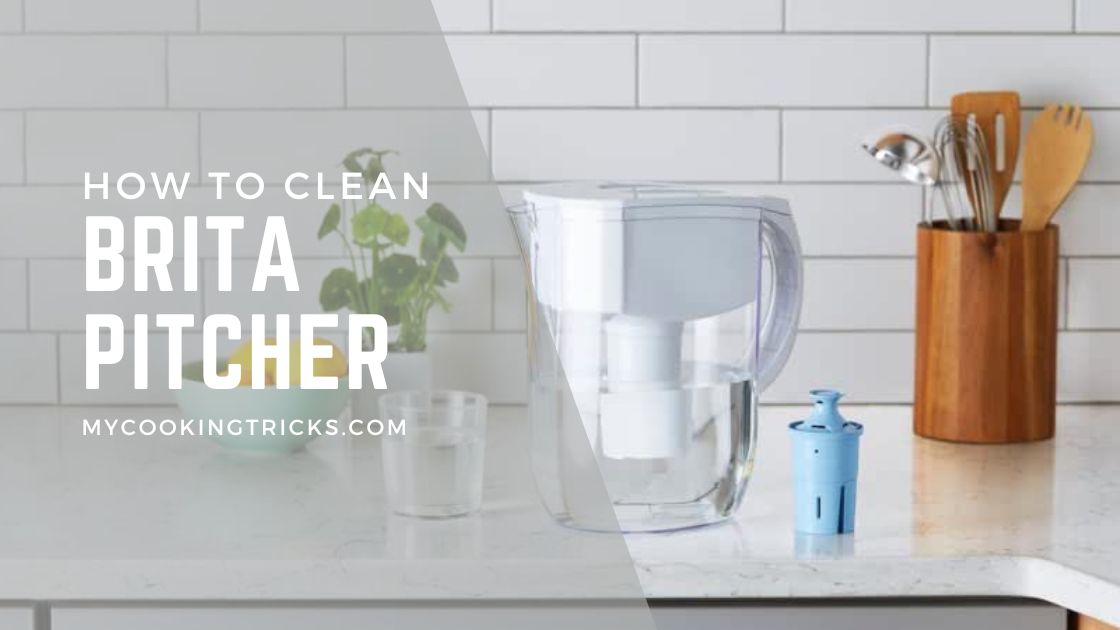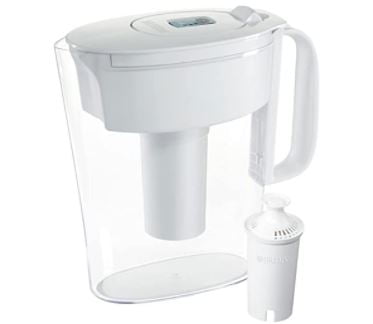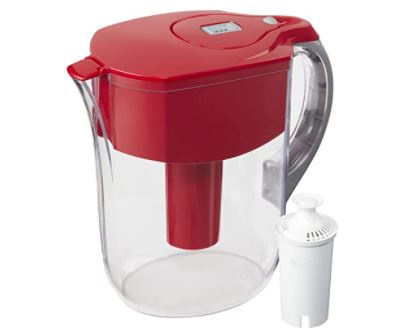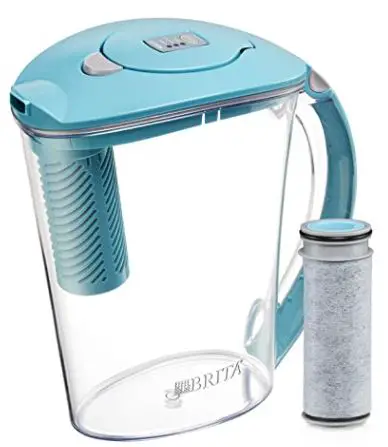How to Clean Brita Pitcher? Have the best pitcher but are unaware of how to clean it properly anf easily? Then you may want to learn how to clean it before it is too late. If you’re going to make the most out of your Brita pitcher, you need to ensure you provide the proper care, including knowing how to clean your pitcher. By learning how to clean Brita pitcher, you’ll also avoid possible health problems.
We get it; cleaning something that holds clean, bacteria-free water is the last thing that comes to your mind. But think about it, thanks to your Brita pitcher, you can drink filtered, fresh, clean water without a care. However, this is only possible if you keep your pitcher in top shape. And just like with any other kitchen utensil, Brita pitchers need to be thoroughly cleaned after a certain period.
But don’t fret; as dreadful as it may sound, you will do it eventually, so why not do it as quickly and as painlessly as possible? To help you in the right direction, learn everything you need to know about cleaning Brita pitchers correctly.
How to Clean Brita Pitcher

For deep and thorough cleaning, follow these six steps:
Tools:
- Dish soap
- Sponge
- White vinegar
- Water
- Measuring cup
- Dishtowel or drying rack
- New filter
Step 1
Take the pitcher apart: Pour out any water, remove the filter, and take the pitcher apart to separate the lid and reservoir. Discard the filter.
Step 2
Wash the pieces: Scrub the lid and reservoir with dish soap and warm water.
Step 3
Attack the mildew: If you still have mildewy bits, make a mixture of one teaspoon white vinegar to one cup of water. Dip your sponge into the mix, then use it to scrub off the mildew.
Step 4
Rinse and dry: Rinse the lid and reservoir with clean water, then set upside down on a dishtowel or drying rack to air dry.
Step 5
Prep the new filter: In the meantime, follow your pitcher model’s instructions to prep the new filter (newer Brita models don’t need the full pre-soak that old ones used to require).
Step 6
Reassemble the pitcher: Put the pieces back together again and follow your pitcher’s instructions for discarding the first three or so pitchers of water until you no longer see carbon dust in the water.
Common Questions How to Clean Brita Pitcher
Can you take apart a Brita pitcher?
The answer would be affirmative. The Brita pitcher comes apart. You can remove the top of the pitcher from the bottom and clean the pieces separately.
Can you use bleach to clean the Brita pitcher?
According to the experts, you should avoid using bleach on your Brita pitcher at all costs while cleaning it. What tends to occur is that most people quickly tend to resort to bleaching when they notice a gradual buildup of greenish mold at the brim of the utensil. However, using bleach also comes with a plethora of adverse effects.
How often should Brita pitcher be cleaned?
Discard the filter (you should be doing this every two to six months). Pitchers don’t need daily cleans as kettles do. However, it would help if you still cleaned them whenever you finished off a pitcherful of water. Once to twice a month, it’s best to give them a more thorough cleaning.
What is the green stuff in my Brita pitcher?
However, if you find unusual green slime in your filter water, it indicates a big issue, algae. You may also notice greenish mold at the brim of the utensil.
Brita filter water may turn green because of algal growth. Not washing your pitcher enough, using healthy water, or leaving your pitcher in direct sunlight can cause algae to thrive in the filtered water.
An open/leaky pitcher left at a warm temperature presents an optimal environment for growing algae, mold, and mildew.
What are mildewed and molds?
Although most of us often observe these greenish particles being developed around the brim of our utensils, we cannot elaborate on what these are.
These are the most stubborn bacteria that always manage to grow around us. As unwanted as these ubiquitous germs are, it becomes even tougher to eradicate these from our homes forever.
Mold Types Include
- Alternaria. The molds commonly grow under kitchen/bathroom sinks, showers, walls, or damp areas.
- Aspergillus. These are the category of the most popular mold and most likely, the ones you often notice in your Brita pitchers. These bacteria are commonly found in greenish, greyish, or blackish colors and can impose dangerous health hazards such as lung inflammation.
- Cladosporium. This type of fungi is commonly found to be growing in colder temperatures. You’ll mostly notice them growing in fabrics, which can cause numerous mild respiratory issues.
- Penicillium. Last but not least, this type of fungi is mainly found growing in materials that have been in higher contact with water. These can cause severe allergic reactions.
Mildew types include
- Powdery mildew. These types of fungi are commonly found in white patches and mainly harm flourishing crops.
- Downy mildew. Widely found in agro products, these fungi are initially yellow and subsequently change into brown.
How to avoid the presence of mold and mildew?
- Maintaining optimal cleanliness and hygiene is the best way to prevent your house or even utensils like Brita filters from being infected by mold and mildew.
- If you want to take it a notch higher, then continue by ensuring that your home’s room temperature doesn’t exceed 40-50 degrees, which can also help lower its chances. The heating/cooling systems must go through scheduled evaluations so that the air circulation inside you is never compromised.
- If you happen to come across any mildew-infested plant in your residence, pluck them out to restrict any spreading.
- White vinegar is an excellent option for cleaning the stubborn mold/mildew growing in your utensils. A little bit of it can easily take on the most stubborn molds.
Can you place a Brita pitcher in the dishwasher?
Brita water filter pitchers and their parts should not go in the dishwasher. Brita filter pitchers are not considered dishwasher-safe. When placed in the dishwasher, a Brita filter and parts could potentially have severe damages.
You may end up with a scratched, melted, or scored pitcher due to the effects of the heated air, hot water, strong detergent, and churning water. Improper care could reduce the ability of the devices to filter water properly.
How to disassemble a Brita pitcher?
Remove the Lid and Wash it.
Take the lid off the pitcher and wash it in the sink with hot water and your basic dishwashing detergent. Wipe it down with a washcloth or sponge, making sure to get into the crevices of the lid as best as you can. For pitchers with electronics in the cap, be sure not to submerge them in water.
For Brita pitchers that feature a chrome lid, mix one teaspoon of vinegar into a cup of warm water and gently wipe the lid down with a soft cloth dipped in the water.
Remove the Filter and Let it Aside.
The filter does not need to be washed; rinse it off with warm water if you want to. Set the filter on a clean surface so you don’t contaminate it.
Remove and Wash the Reservoir
Take the water reservoir out of the pitcher, and put it in the sink if it has one. Using a mild dish detergent and warm water, wipe the reservoir down with a soft cloth. Be sure to wipe the inside and outside of the reservoir and the cradle where the filter sits.
What are the types of Brita pitchers?
Among the most sought-after models, we find:
Brita Standard Metro Water Filter Pitcher
The slim, BPA-free Metro water pitcher with filter holds 5 cups of water, enough to fill two 24-ounce reusable water bottles.
Brita is the number 1 water filter, reducing chlorine (taste & odor), Mercury, Copper, Zinc, and Cadmium; always get cleaner, filtered water with an electronic indicator that makes filter reminders effortless.
This space-efficient Brita pitcher perfectly fits refrigerator shelves, features an easy-fill locking lid, and is easy to pour.

Features:
- Plastic
- 40 Gallons Capacity
- BPA-free
Brita Extra Large 18 Cup Filtered Water Dispenser with 1 Standard Filter
Features:
- The UltraMax water dispenser is made without BPA and can hold 27 cups of water, enough to fill nine 24-ounce reusable water bottles; packaging may vary
- Get great tasting water without the waste; by switching to Brita, you can save money^ and replace 1,800 single-use plastic water bottles* a year
- This space efficient filtered water dispenser is fridge friendly, features an easy locking lid and precision pour spigot; Height 10.47″; Width 5.67″; Length/Depth 14.37″; Weight 3 pounds
- Brita is the #1 water filter§ reducing chlorine (taste and odor), Mercury, Copper, and more***; get cleaner**, filtered water with a helpful sticker indicator that makes filter reminders effortless
- Compatible with Elite and Standard filters; replace your Elite filter after 120 gallons or approximately every 6 months or Standard filter after 40 gallons or approximately every 2 months
Brita Standard Grand Water Filter Pitcher
This red Brita pitcher has an ergonomic design which makes pouring easy. With the flip-top lid, refilling is a breeze, and just a glance at the electronic filter indicator lets you know when it is time to change the Brita replacement filter.
This large water pitcher comes with one water filter, which should be changed every 40 gallons or two months for best results. Start drinking healthier, great-tasting water with Brita today.

Features:
- BPA-free
- 40 Gallons Capacity
- Ergonomic design
Brita Stream Rapids Water Filter Pitcher
Drink cleaner, great-tasting water with this BPA-free Brita 10 cup water filtration pitcher. Brita StreamFilter-As-You-Pour technology allows you to enjoy great-tasting water and is the only pitcher that filters water as you pour, so you don’t have to wait at the sink for water to filter.
When you pour the water into a glass, the water flows through the filter, reducing chlorine (taste and odor) and more.
The Brita Stream pitcher is compatible only with Brita Stream filters and comes with 1 Stream Pitcher Filter. For best results, the filter should be changed every 40 gallons, about two months for the average household.

Features:
- 40 Gallons Capacity
- Plastic
- BPA-free
What are the Benefits of Cleaning a Brita Pitcher
Cleaning a Brita pitcher is a simple process that can be completed in a few minutes. The pitcher itself is not difficult to clean, but it is important to clean it regularly to maintain its performance and to prevent bacteria from growing.
The first step is to remove the filter from the pitcher. The filter should be rinsed with water to remove any dirt or debris. Next, the pitcher should be washed with warm soapy water. The lid and base of the pitcher should be scrubbed with a brush to remove any build-up.
Once the pitcher is clean, it is important to dry it completely before replacing the filter. This will help to prevent bacteria from growing. Brita pitchers should be cleaned at least once a month to maintain their performance and to prevent the growth of bacteria. Thanks for reading! How often do you clean your Brita pitcher? Let us know in the comments below!
Cleaning a Brita pitcher is a simple process that can be completed in a few minutes. The pitcher itself is not difficult to clean, but it is important to clean it regularly to maintain its performance and to prevent bacteria from growing.
The first step is to remove the filter from the pitcher. The filter should be rinsed with water to remove any dirt or debris. Next, the pitcher should be washed with warm soapy water. The lid and base of the pitcher should be scrubbed with a brush to remove any build-up.
Once the pitcher is clean, it is important to dry it completely before replacing the filter. This will help to prevent bacteria from growing. Brita pitchers should be cleaned at least once a month to maintain their performance and to prevent the growth of bacteria.
Features To Look for a Brita Pitcher
Brita pitchers come in a variety of sizes and styles, but they all have some common features. Look for a Brita pitcher with a large capacity, as this will reduce the number of times you need to refill it. The pitcher should also be easy to grip, with a comfortable handle. Some models include a filter indicator that signals when it’s time to replace the filter. Choose a pitcher that is easy to clean, with few nooks and crannies where dirt and grime can hide.
When it comes to price, you’ll find Brita pitchers at a wide range of price points. In general, the larger the capacity and the more features the pitcher has, the higher the price will be. However, you can find good quality Brita pitchers at a variety of price points. Consider how often you’ll use the pitcher and how easy it is to clean before making your final decision.
Now that you know what to look for in a Brita pitcher, it’s time to learn how to clean one. The good news is that Brita pitchers are easy to clean, and only require a few simple steps.
Start by removing the filter from the pitcher. Rinse the filter under running water to remove any dirt or debris. Next, fill the pitcher with equal parts water and white vinegar. Let the mixture sit for 30 minutes, then empty the pitcher and rinse it under running water. Finally, replace the filter and fill the pitcher with fresh water.
Cleaning your Brita pitcher is easy and only takes a few minutes. By following these simple steps, you can ensure that your Brita pitcher stays clean and continues to provide great-tasting, filtered water.
How to Choose a Brita Pitcher
When it comes to choosing a Brita pitcher, there are a few things to consider. Capacity is one important factor, as you’ll want a pitcher that can hold enough water to meet your needs. Look for a model with an easy-to-grip handle, and choose one that comes with a filter indicator to help you remember when to replace the filter. Be sure to also select a pitcher that is easy to clean, with few nooks and crannies where dirt and grime can hide. With so many Brita pitchers to choose from, you’re sure to find one that meets your needs.
Do Brita pitchers come apart to clean?
Yes, the Brita pitcher comes apart for easy cleaning. The filter and lid detach from the main carafe for thorough cleaning. The filter should be replaced every two months for optimum performance.
What is the best way to clean my Brita pitcher?
The best way to clean your Brita pitcher is to disassemble it and wash all parts in warm, soapy water. Be sure to rinse all of the parts thoroughly before reassembling your pitcher. You should also sanitize your Brita pitcher once a month by soaking all the parts in a solution of one vinegar to ten parts water.
How can I clean the spout of my Brita pitcher?
Your Brita pitcher’s spout can be cleaned using a cotton swab dipped in vinegar. Gently scrub the inside of the spout with the cotton swab until all of the build-up has been removed. Rinse the spout thoroughly with water before reattaching it to the pitcher.
How do I clean the lid of my Brita pitcher?
The lid of your Brita pitcher can be cleaned by soaking it in a solution of vinegar and water. Be sure to rinse the lid thoroughly with water before putting it back on your pitcher. If your lid is dishwasher-safe, you can also clean it by running it through a cycle in your dishwasher.
How do I clean the filter of my Brita pitcher?
The filter of your Brita pitcher can be cleaned by soaking it in a solution of one part vinegar to ten parts water. Be sure to rinse the filter thoroughly with water before putting it back in your pitcher. You should also replace your filter every two months for optimum performance.
How do I clean the carafe of my Brita pitcher?
The carafe of your Brita pitcher can be cleaned by soaking it in a solution of one part vinegar to ten parts water. Be sure to rinse the carafe thoroughly with water before putting it back in your pitcher. You can also clean the carafe by running it through a cycle in your dishwasher.
How do I descale my Brita pitcher?
You can descale your Brita pitcher by soaking all the parts in a solution of one vinegar to ten parts water. Be sure to rinse all of the parts thoroughly with water before reassembling your pitcher. You should also descale your Brita pitcher once a month to prevent the build-up of calcium and other minerals.
How do I clean my Brita pitcher if it is dishwasher-safe?
If your Brita pitcher is dishwasher-safe, you can clean it by running it through a cycle in your dishwasher. Be sure to rinse all of the parts thoroughly with water before reassembling your pitcher. You should also sanitize your Brita pitcher once a month to prevent the build-up of bacteria and other contaminants.
How do I store my Brita pitcher?
You should store your Brita pitcher in a cool, dry place. Be sure to rinse all of the parts thoroughly with water before putting it away. You should also sanitize your Brita pitcher once a month to prevent the build-up of bacteria and other contaminants.
Can you clean a Brita filter with vinegar?
You can clean a Brita filter with vinegar, but it’s not necessary. You can simply rinse the filter with water after each use. If you do choose to clean your filter with vinegar, soak it in a solution of one part water and one part vinegar for 15 minutes. Then, rinse the filter with water.
How often should you replace your Brita filter?
You should replace your Brita filter every two months or after 40 gallons of use, whichever comes first.
Can you clean a Brita filter with vinegar?
Yes, you can clean a Brita filter with vinegar. The vinegar will help to dissolve any build-up and sediment that may have accumulated in the filter. Brita recommends that you clean your filter with vinegar every two weeks.
To clean your Brita filter with vinegar, fill a bowl with one cup of distilled white vinegar and let the filter soak for 15 minutes. After 15 minutes, rinse the filter under cold water until the water runs clear. You can then reattach the filter to your Brita pitcher and continue using it as usual.
If you notice that your filter is still not performing as well as it should after cleaning it with vinegar, Brita recommends replacing it. You can purchase replacement filters at most major retailers or online through Brita’s website.
Does bacteria grow in Brita filters?
Bacteria can grow in Brita filters, but it’s not common. To prevent bacteria growth, rinse the filter with cold water and vinegar every month. If you see mold or mildew on the filter, replace it immediately.
How do I clean a Brita water bottle?
To clean a Brita water bottle, remove the filter and wash the bottle with warm, soapy water. Rinse well and dry before putting the filter back in. You can also put the bottle in the dishwasher (without the filter).
How do I clean my Brita faucet filtration system?
To clean your Brita faucet filtration system, remove the filter and wash it with warm, soapy water. Rinse well and dry before putting the filter back in. You can also put the filter in the dishwasher (without the housing).
How often should I change my Brita filter?
You should change your Brita filter every two to three months.
How do I know when it’s time to change my Brita filter?
If your water starts to taste bad or smells foul, it’s time to change the filter. You should also check the expiration date on the filter and replace it if it’s more than six months old.
How do I dispose of my old Brita filter?
You can recycle your old Brita filter. Check with your local recycling center to see if they accept Brita filters. You can also mail your filter back to Brita for recycling.
How do I clean my Brita pitcher if it’s dishwasher-safe?
To clean your Brita pitcher in the dishwasher, remove the filter and put the pitcher on the top rack. Wash on the normal cycle with detergent. Rinse well and dry before putting the filter back in.
How do I clean my Brita pitcher if it’s not dishwasher-safe?
To clean your Brita pitcher by hand, remove the filter and wash the pitcher with warm, soapy water. Rinse well and dry before putting the filter back in.
How do I clean my Brita faucet filtration system if it’s dishwasher-safe?
To clean your Brita faucet filtration system in the dishwasher, remove the filter and put it on the top rack. Wash on the normal cycle with detergent. Rinse well and dry before putting the filter back in.
How do I clean my Brita faucet filtration system if it’s not dishwasher-safe?
To clean your Brita faucet filtration system by hand, remove the filter and wash it with warm, soapy water. Rinse well and dry before putting the filter back in.
How often should I descale my Brita pitcher?
You should descale your Brita pitcher every two to three months.
How do I descale my Brita pitcher?
To descale your Brita pitcher, remove the filter and fill the pitcher with a mixture of equal parts water and vinegar. Let it soak for 12 hours, then rinse well and dry before putting the filter back in.
How often should I sanitize my Brita pitcher?
You should sanitize your Brita pitcher every two to three months.
How do I sanitize my Brita pitcher?
To sanitize your Brita pitcher, remove the filter and fill the pitcher with a mixture of equal parts water and bleach. Let it soak for 30 minutes, then rinse well and dry before putting the filter back in.
How do I clean my Brita faucet filtration system if it has a detachable spout?
To clean your Brita faucet filtration system with a detachable spout, remove the filter and spout. Wash both with warm, soapy water. Rinse well and dry before putting the filter and spout back in.
How do I clean my Brita faucet filtration system if it doesn’t have a detachable spout?
To clean your Brita faucet filtration system without a detachable spout, remove the filter and soak it in a mixture of equal parts water and vinegar for 30 minutes. Rinse well and dry before putting the filter back in.
How often should I change my Brita faucet filtration system’s filter?
You should change your Brita faucet filtration system’s filter every two to three months.
How do I know when it’s time to change my Brita faucet filtration system’s filter?
If your water tastes bad or smells foul, it’s time to change the filter. You should also check the expiration date on the filter and replace it if it’s more than six months old.
How do I remove limescale from my water filter jug?
To clean Brita pitcher, fill it with cold water and add 1/2 cup of white vinegar. Let sit for an hour, then rinse thoroughly. If there is still build-up, use a denture tablet or descaling solution. Brita recommends using a new filter after cleaning.
Additional Tips on How to Clean Brita Pitcher
- If you’re observing mold at the bottom, it’s best to replace the filter itself. The best way to approach such instances is by throwing away the mold-covered screen.
- Generally, it’s always advised to replace the Brita filter every two months or after an average usage of 40 gallons.
- For Brita pitchers that feature a chrome lid, mix one teaspoon of vinegar into a cup of warm water and gently wipe the lid down with a soft cloth dipped in the water.
- Set it upside down on a drying rack or on a clean towel on your counter or table to let the pitcher dry. Drying the pitcher with a towel may leave tiny fibers which will get into your water.
Do you by any change also own a grinder? Would you like to know how to clean a grinder?


